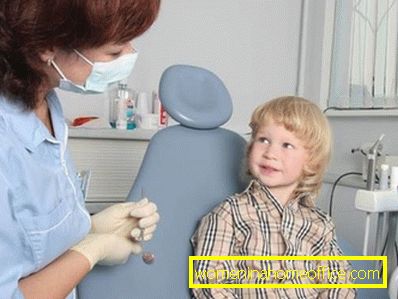Pulpitis
Pulpitis is an inflammatory process in the pulp that is common in dental practice. No one is immune from this disease. The pulpitis develops due to the complication of caries, and may also be a consequence of the wrong actions of the doctor. The disease is treatable, but only a dentist can do it.
Main signs and symptoms of pulpitis
Pulpitis is an inflammation that occurs in the neurovascular bundle of a tooth, which is often defined only as a nerve. In general, pulpitis is characterized by continuous tooth ache, which is especially pronounced at night. Some patients report fever and heat.

The initial stage of pulpitis is characterized by infrequent aching pains, and neglected forms occur with a constant increase in pain. Gradually, the pain is only aggravated, becoming pulsating and prolonged. The chronic form proceeds with pain only during the exacerbation, while it has a paroxysmal character. Moreover, the pain arises spontaneously - that is, without the influence of any irritating factors on the tooth.
In acute focal and diffuse pulpitis, the main symptoms are the pain of spreading nature along the branches of the trigeminal nerve. Strengthening it also manifests itself at night.
A diseased tooth is sensitive to the stimuli acting on it, and their removal does not contribute to the reduction of unpleasant sensations. When tapping a tooth, sensitivity may be completely absent.
Gangrenous chronic pulpitis can occur with severe pain, the tooth is extremely sensitive to the effects of hot on it, while the cold, on the contrary, has a sedative effect. If you do not start treatment in time, pulpitis can lead to periodontitis, which is even more difficult to cure.
Pulpitis baby tooth: features
- Pulpitis baby tooth slightly different clinical picture. This is mainly due to the peculiarity of the structure of bone tissue and the state of the child's body. The milky tooth is thinner and with a larger cavity where the pulp is. Therefore, caries of a baby tooth relatively quickly develops into pulpitis. In children, the disease is much more common than in adults.
- The child may complain of pain in the evening while eating, and the inflammatory exudate can gradually go out through inflammation into the carious cavity, causing the chronic form of pulpitis. During tapping on a sick baby tooth, there are unpleasant sensations. This is due to the fact that the pulp in the milk tooth is massive, and its edema appears during inflammation. And when tapping the tooth (percussion), the shaking of a massive pulp causes a painful sensation.
- Gradually, the child may begin to complain of increased pain in the tooth, it takes a constant aching shape. In children with a good immune system, often acute pulpitis is accompanied by pain and swelling (swelling of the cheek), as in periostitis or periodontitis. Body temperature may rise. This is the child's body's response to the inflammatory process in the pulp.
- If you suspect pulpitis, immediately contact your dentist for help - folk remedies will not help you, but only for a time will muffle the pain.

Pulpitis: home treatment
When pulpitis home methods are applied only in the case when there is no possibility to immediately consult a doctor. Folk remedies only alleviate the main symptoms and complement conservative therapy, but they are by no means a treatment.
- A very effective means of traditional medicine for the treatment of pulpitis is garlic. Rub the wrist of that hand, which is opposite to the aching tooth. After put on the wrist compress garlic gruel. To prevent burns from burning juice, use a thin rag.
- Cut the onion and stick it with the thumb near the nail, which is on the opposite hand from the aching tooth.
- Put a small piece of propolis on the aching tooth, cover with a cotton swab and hold for about 20 minutes. Instead of propolis, you can take a piece of bacon or raw beets. The pain should subside.
- Do not forget to rinse. Alcohol will be effective tincture of sage, willow bark, calamus, pomegranate, bay leaf and chamomile. Excellent result gives rinsing with soda solution or hydrogen peroxide.
- You can attach a piece of aloe without a peel to the gum of a sick tooth. And to relieve inflammation, place the root of the plantain in the ear.
It is good if you take anti-inflammatory and pain medication.
Why does a toothache ache after pulpitis treatment

The pain after the treatment of pulpitis may in some cases be legitimate, and in some - the result of dental errors. After the treatment of pulpitis, it is imperative to make a control X-ray, which shows how well or poorly the filling is performed.
Among the main causes of pain in the tooth after the treatment of pulpitis are the following:
- Trauma to the tissues in the apex of the tooth root. If the tooth was sealed correctly, the toothache after removal of the nerve lasts no more than 3 days, then disappears.
- Poor root canal filling. In this case, it is necessary to completely re-treat the tooth and the sooner the better, until inflammation at the apex does not lead to its loss.
- Sealing material displayed over the top of the root. The pain is not severe and can pass on its own in 1 to 2 months.
- Breaking off the instrument in the root canal, which will lead to the multiplication of infections in the non-sealed part and will develop inflammation in the tissues surrounding the tooth.
- Perforation of the root of the tooth, which is often associated with the negligence of the doctor (but not always). To close the perforations apply special expensive materials.
Pulpitis is quite a serious tooth disease that requires dental intervention. When the first signs of pulpitis occur, do not tolerate the pain and do not try to cure it with folk remedies - this will not help. For the treatment of the disease you need to consult a doctor who will determine the cause of the disease and will do everything necessary to save the tooth.